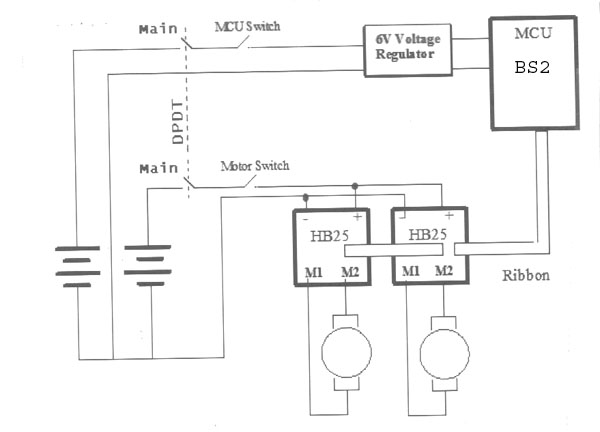please help
Hi, everyone. I have designed a robotic platform (wood) that uses two HB25s in the
arrangment shown in the attached figure. Everything works very well and the platform
responds very well to my needs.
The problem is that if I do not use the system for a period of say a week or two I notice
that the MCU battery has dropped about 1 volt maybe more sometimes, while the motor
battery has·maintained its voltage.
I thought that my MCU battery was licking, but when I disconnected it from the circuit·and checked it
independently the voltage was OK and remained so.
So my question·is, is it possible that·my circuit has an inherent "lickage" path that works even if the
switches are all off. Is that possible? If so can I have some help to correct the circuit?
Thanks, John
arrangment shown in the attached figure. Everything works very well and the platform
responds very well to my needs.
The problem is that if I do not use the system for a period of say a week or two I notice
that the MCU battery has dropped about 1 volt maybe more sometimes, while the motor
battery has·maintained its voltage.
I thought that my MCU battery was licking, but when I disconnected it from the circuit·and checked it
independently the voltage was OK and remained so.
So my question·is, is it possible that·my circuit has an inherent "lickage" path that works even if the
switches are all off. Is that possible? If so can I have some help to correct the circuit?
Thanks, John



Comments
▔▔▔▔▔▔▔▔▔▔▔▔▔▔▔▔▔▔▔▔▔▔▔▔
Don't worry. Be happy
I will do it tonight and check it out.
John
I assume that you are using multiple AA batterys for your motor circuit. Since the current capacity is much greater for your motor circuit, the voltage will not drop because of loaded conditions (even though current drain is greater for your motor circuit when connected). If you have good batterys all around AND you don't have any shorts AND you still get a slight drop in voltage across your 9 volt battery, your MCU / battery combination might be slightly weak whereas your motor / battery combination is probably good. If you can get 12 or so hours of operation from your 9 volt battery, you should be good.
Bottom line, put a ammeter in series with the + side of the 9 volt battery with all swithes off (as suggested by dev/null). If you don't measure any current, then you might just have a weak battery. If you do measure current, then you have a short somewhere that you need to fix ASAP. Hope this helps.
Bob
NiMH batteries·will discharge to air over a period of time.· NiCads can suffer from memory effects.· A smaller battery that's recharged often, for instance, may lose power more quickly than a larger one that's recharged less frequently.
·
The problem is probably the HB25s. Their internal power ground is tied to their internal signal ground (the MCU). This means that over time, the MCU battery is going to drain via this internal HB25 ground.
The only thing I really know about HB25s is that I use a bunch of them, they are GREAT motor controllers, and a Parallax tech told me what I wrote above concerning a situation I had with one of my robots that was never solved while it had a seperate MCU battery.
HOWEVER, I did solve it by eliminating the MCU battery and building a DC-DC converter that allowed my dual 12 volt, lead acid batteries to also power the Stamps. (There were five of them.) I am not enough of an electronics buff to know if the Stamps still drained the 12 volt system, or not. However, the 12 volt system provided 24 amp hours and would power the Stamps for a VERY long time, if necessary. (In other words, the 'bot could sit for months and I could not tell via voltmeter if the 12 volt system was down more than a few hundredths of an amp.)
If you had to maintain your configuration, I guess you could put some kind of MCU operated relay (SSR or something else) in between the Stamp ground and the HB25 ground. (I am on·shaky ground here. Maybe someone that knows more will chime in.)
I am interested in how you solve this problem and hope you will keep us updated.
--Bill
▔▔▔▔▔▔▔▔▔▔▔▔▔▔▔▔▔▔▔▔▔▔▔▔
You are what you write.
Post Edited (Bill Chennault) : 8/14/2009 2:14:11 AM GMT